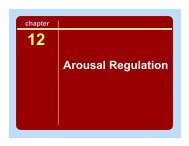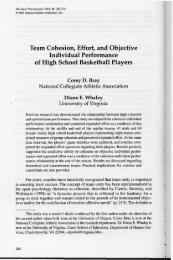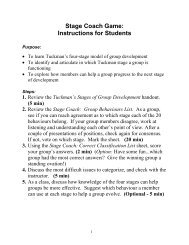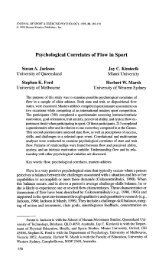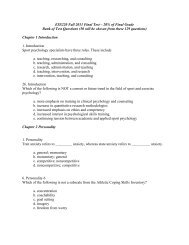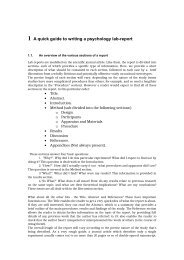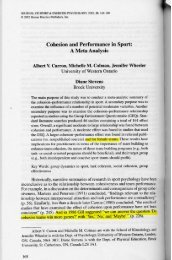The Development of Imagery in Dance
The Development of Imagery in Dance
The Development of Imagery in Dance
You also want an ePaper? Increase the reach of your titles
YUMPU automatically turns print PDFs into web optimized ePapers that Google loves.
26 Volume 10, Numbers I & 2, 20U6 • Journal oi' <strong>Dance</strong> Medic<strong>in</strong>e 6" Science<br />
were encouraged to image by others,<br />
such as teachers. Family, or other<br />
daticers. Otily some participants<br />
identified particular reasons for why<br />
they started us<strong>in</strong>g imagery, such as<br />
for learn<strong>in</strong>g ot for choreograph<strong>in</strong>g.<br />
Moreover, it was noted that only<br />
thtee <strong>of</strong> the <strong>in</strong>terviewees had received<br />
any dance or sports psychology<br />
tra<strong>in</strong><strong>in</strong>g, and even then It was only<br />
from pass<strong>in</strong>g references or occasional<br />
workshops.<br />
Some participants voiced a concern<br />
that imagery is an <strong>in</strong>ternal<br />
experience that cannot be taught,<br />
which might be due to a lack <strong>of</strong><br />
awareness by dancers that imagery is<br />
a skill. While no such sttidies have yet<br />
taken place <strong>in</strong> dance, there is plenty<br />
<strong>of</strong> evidence trom sports literature that<br />
athletes may improve their itnagery<br />
through formal tra<strong>in</strong><strong>in</strong>g programs.**''<br />
It has also been shown that coaches<br />
can enhance practice quality through<br />
undertak<strong>in</strong>g a similar psychological<br />
skills tra<strong>in</strong><strong>in</strong>g program.''' Other authors<br />
have noted that perform<strong>in</strong>g arts<br />
programs typically do not <strong>in</strong>clude<br />
psychological skills education, but<br />
that dancers could benefit greatly<br />
from its <strong>in</strong>troductioti.'^-^ Weencourage<br />
such imagery tra<strong>in</strong><strong>in</strong>g for dancers<br />
and their teachers, but even <strong>in</strong> the<br />
absence <strong>of</strong> formal programs, dance<br />
teachers should be encouraged to use<br />
imagery. 'Jhey can do this by giv<strong>in</strong>g<br />
Ota metaphorical images, by <strong>in</strong>form<strong>in</strong>g<br />
dancers that imagery is a skill that<br />
can be improved, and by encourag<strong>in</strong>g<br />
dancers to mentally practice us<strong>in</strong>g<br />
imagery. Other dance imagery writers<br />
have also provided useful recommendations<br />
for how to develop imagery<br />
skills <strong>in</strong> dancers.' •'"'•'- However, the<br />
validity <strong>of</strong> these recommendations<br />
has not yet been <strong>in</strong>vestigated.<br />
It appears that imagery structure<br />
and deliberation <strong>in</strong>creased as the<br />
dancers became more experienced.<br />
This fmd<strong>in</strong>g is <strong>in</strong> agreement with<br />
evidence that elite athletes have more<br />
structured and tegular imagery sessions<br />
than do novices.*''^ Because it<br />
has been claimed that imagery sessions<br />
need to be structured to be effective J<br />
<strong>in</strong>creased structure <strong>in</strong> imagery teach<strong>in</strong>g<br />
should probably be promoted. It<br />
has previously been shown that an<br />
imagery tra<strong>in</strong><strong>in</strong>g program can help<br />
<strong>in</strong>crease both the frequency and the<br />
structtire <strong>of</strong> imagery practice.''"" In<br />
addition to improvements <strong>in</strong> structure,<br />
our dancers typically experienced<br />
more muiti-sensory or more k<strong>in</strong>esthetic<br />
images as well as greater image<br />
quality, complexity and control as they<br />
became tnore experienced. Aga<strong>in</strong> this<br />
resembles some previous f<strong>in</strong>d<strong>in</strong>gs <strong>in</strong><br />
sports. •^•'•' Moreover, the dancers had<br />
generally <strong>in</strong>creased their amount <strong>of</strong><br />
imagery as they progressed. This conctirs<br />
with the f<strong>in</strong>d<strong>in</strong>gs ot Brasslngton<br />
and Adam, who showed that the more<br />
experienced soloists <strong>in</strong> ballet u.se more<br />
psychological skills, such as imagery,<br />
than the less experienced corps de ballet<br />
dancers.''^ Bradley and Part<strong>in</strong>gton<br />
found that more advanced Highland<br />
dancers also engaged <strong>in</strong> more imagery<br />
than their lower-level counterparts."'<br />
Similarly, a consistent f<strong>in</strong>d<strong>in</strong>g <strong>in</strong><br />
sports has been that elite athletes<br />
use more imagery than do non-elite<br />
athelctes.'-''-'^-* What none <strong>of</strong> these<br />
studies have addressed, however, is<br />
whether the greater use <strong>of</strong> imagery<br />
on be-half <strong>of</strong> more skilled dancers is<br />
a result <strong>of</strong> their typically longer and<br />
more <strong>in</strong>tense <strong>in</strong>volvement <strong>in</strong> their<br />
activity compared to their less skilled<br />
counterparts, or whether other factors<br />
underlie this difference. We address<br />
this question further <strong>in</strong> Part II.<br />
One <strong>of</strong> the factors that could<br />
affect a performer's imagery use is<br />
the encouragement received from<br />
significant others. In the present<br />
study, <strong>in</strong>dividual differences existed<br />
as to whether the participants had<br />
been encouraged to image. Specifically,<br />
only some <strong>of</strong> them had received<br />
such encouragement, and many reported<br />
that imagery use was simply<br />
expected at the pr<strong>of</strong>essional level,<br />
imply<strong>in</strong>g that encouragement was<br />
not necessary. However, a qualitative<br />
study with athletes suggests that<br />
encouragement does have a positive<br />
effect on the amount <strong>of</strong> imagery<br />
used,'''' and this would be an <strong>in</strong>terest<strong>in</strong>g<br />
f<strong>in</strong>d<strong>in</strong>g for future research to<br />
verify with dancers. Encouragement<br />
might also vary with activity type,<br />
for exatnple, sports or dance,'" or<br />
experience level.'' Aga<strong>in</strong>, we explore<br />
ftirther <strong>in</strong> Part II the issue ot whether<br />
a relationship exists between imagery<br />
encouragement and imagery use.<br />
<strong>Dance</strong>rs also reported that teachers<br />
may <strong>in</strong>fluence the imagery process<br />
by provid<strong>in</strong>g metaphorical images<br />
<strong>in</strong> class. As young dancers most had<br />
received these types <strong>of</strong> images frequently,<br />
and it was suggested that<br />
enhanced understand<strong>in</strong>g, <strong>in</strong>terest,<br />
enjoyment, and movement quality<br />
were the reasons for giv<strong>in</strong>g such images.<br />
However, several dancers also<br />
reported that this teach<strong>in</strong>g practice<br />
had decl<strong>in</strong>ed across their career. By<br />
contrast, Overhy has reported a more<br />
even distribution <strong>of</strong> images given to<br />
beg<strong>in</strong>ner, <strong>in</strong>termediate and advanced<br />
dancers." Given these discrepancies,<br />
the question ot what is typical teach<strong>in</strong>g<br />
practice can be better addressed<br />
by the quantitative data presented<br />
<strong>in</strong> Part 11. 'Ihe value <strong>of</strong> qualitative<br />
research is, however, highlighted<br />
thtough <strong>in</strong>dtictively-emerg<strong>in</strong>g data<br />
such as the quotes <strong>in</strong>dicat<strong>in</strong>g that<br />
the dancers <strong>in</strong> tact reported a pretercnce<br />
for teachers who gave plenty <strong>of</strong><br />
metaphorical images, 'thus, the use <strong>of</strong><br />
a semistructured <strong>in</strong>terview approach<br />
to explore imagery development <strong>in</strong><br />
dance yielded f<strong>in</strong>d<strong>in</strong>gs that were not<br />
anticipated, but that can have value<br />
both for further research as well as for<br />
applied dance psychology contexts.<br />
In conclusion, we have shed some<br />
light on dancers' imagery development,<br />
<strong>in</strong>clud<strong>in</strong>g their imagery experiences,<br />
the role <strong>of</strong> their teachers,<br />
and the changes <strong>in</strong> their imagery as<br />
they progressed. By us<strong>in</strong>g qualitative<br />
methods, we were able to explore<br />
these phenomena <strong>in</strong> depth and<br />
without impos<strong>in</strong>g restrictions on<br />
the dancers' responses. As such, om'<br />
study also allows a more <strong>in</strong>formed<br />
design <strong>of</strong> subsequent quantitative<br />
<strong>in</strong>vestigations, such as that reported<br />
<strong>in</strong> Part II. An <strong>in</strong>terim conclusion that<br />
may be drawn from the <strong>in</strong>terview<br />
f<strong>in</strong>d<strong>in</strong>gs is that imagery is perceived<br />
to be an important practice activity<br />
throughout the pr<strong>of</strong>essional dancers'<br />
careers, which also <strong>in</strong>dicates the potential<br />
value <strong>of</strong> further study <strong>in</strong>to the<br />
topic. In the words <strong>of</strong> Contemporary



